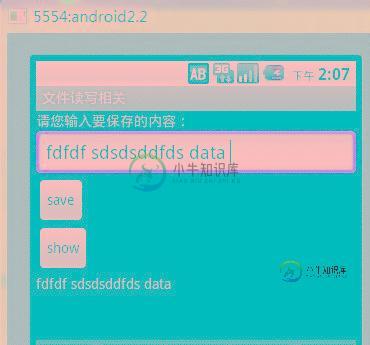Android应用程序中读写txt文本文件的基本方法讲解

最终效果图,点击save会保存到文件中,点击show会从文件中读取出内容并显示。

main.xml
<?xml version="1.0" encoding="utf-8"?> <LinearLayout xmlns:android="http://schemas.android.com/apk/res/android" android:orientation="vertical" android:layout_width="fill_parent" android:layout_height="fill_parent" > <TextView android:layout_width="fill_parent" android:layout_height="wrap_content" android:text="请您输入要保存的内容:" /> <EditText android:id="@+id/addText" android:layout_width="fill_parent" android:layout_height="wrap_content" android:hint="请您在此处输入文件内容!" /> <Button android:id="@+id/addButton" android:layout_width="wrap_content" android:layout_height="wrap_content" android:text="save" /> <Button android:id="@+id/showButton" android:layout_width="wrap_content" android:layout_height="wrap_content" android:text="show" /> <TextView android:id="@+id/showText" android:layout_width="fill_parent" android:layout_height="wrap_content" /> </LinearLayout>
activity代码
package cn.com.file;
import java.io.ByteArrayOutputStream;
import java.io.FileInputStream;
import java.io.FileNotFoundException;
import java.io.FileOutputStream;
import java.io.IOException;
import android.app.Activity;
import android.os.Bundle;
import android.view.View;
import android.view.View.OnClickListener;
import android.widget.Button;
import android.widget.EditText;
import android.widget.TextView;
import android.widget.Toast;
public class FileTest extends Activity {
private EditText editText;
private TextView showTextView;
// 要保存的文件名
private String fileName = "chenzheng_java.txt";
@Override
public void onCreate(Bundle savedInstanceState) {
super.onCreate(savedInstanceState);
setContentView(R.layout.main);
// 获取页面中的组件
editText = (EditText) findViewById(R.id.addText);
showTextView = (TextView) findViewById(R.id.showText);
Button addButton = (Button) this.findViewById(R.id.addButton);
Button showButton = (Button) this.findViewById(R.id.showButton);
// 绑定单击事件
addButton.setOnClickListener(listener);
showButton.setOnClickListener(listener);
}
// 声明监听器
private View.OnClickListener listener = new OnClickListener() {
public void onClick(View v) {
Button view = (Button) v;
switch (view.getId()) {
case R.id.addButton:
save();
break;
case R.id.showButton:
read();
break;
}
}
};
/**
*@author chenzheng_Java
*保存用户输入的内容到文件
*/
private void save() {
String content = editText.getText().toString();
try {
/* 根据用户提供的文件名,以及文件的应用模式,打开一个输出流.文件不存系统会为你创建一个的,
* 至于为什么这个地方还有FileNotFoundException抛出,我也比较纳闷。在Context中是这样定义的
* public abstract FileOutputStream openFileOutput(String name, int mode)
* throws FileNotFoundException;
* openFileOutput(String name, int mode);
* 第一个参数,代表文件名称,注意这里的文件名称不能包括任何的/或者/这种分隔符,只能是文件名
* 该文件会被保存在/data/data/应用名称/files/chenzheng_java.txt
* 第二个参数,代表文件的操作模式
* MODE_PRIVATE 私有(只能创建它的应用访问) 重复写入时会文件覆盖
* MODE_APPEND 私有 重复写入时会在文件的末尾进行追加,而不是覆盖掉原来的文件
* MODE_WORLD_READABLE 公用 可读
* MODE_WORLD_WRITEABLE 公用 可读写
* */
FileOutputStream outputStream = openFileOutput(fileName,
Activity.MODE_PRIVATE);
outputStream.write(content.getBytes());
outputStream.flush();
outputStream.close();
Toast.makeText(FileTest.this, "保存成功", Toast.LENGTH_LONG).show();
} catch (FileNotFoundException e) {
e.printStackTrace();
} catch (IOException e) {
e.printStackTrace();
}
}
/**
* @author chenzheng_java
* 读取刚才用户保存的内容
*/
private void read() {
try {
FileInputStream inputStream = this.openFileInput(fileName);
byte[] bytes = new byte[1024];
ByteArrayOutputStream arrayOutputStream = new ByteArrayOutputStream();
while (inputStream.read(bytes) != -1) {
arrayOutputStream.write(bytes, 0, bytes.length);
}
inputStream.close();
arrayOutputStream.close();
String content = new String(arrayOutputStream.toByteArray());
showTextView.setText(content);
} catch (FileNotFoundException e) {
e.printStackTrace();
} catch (IOException e) {
e.printStackTrace();
}
}
}
其他的都为默认。
关于文件保存的路径可以通过ADT携带的File Explorer工具进行查看。如何调出File Explorer工具呢;我们可以通过Windows--showView--others-android下面看到File Explorer。这里是我的一个截图。

对于这个程序,基本上没什么难点,就是纯粹的java流知识。唯一不同的就是context为我们提供了两个方法来获取输入输出流。简单、方便、快捷啊。
-
本文向大家介绍C#读写文本文件的方法,包括了C#读写文本文件的方法的使用技巧和注意事项,需要的朋友参考一下 本文实例讲述了C#读写文本文件的方法。分享给大家供大家参考。具体分析如下: System.IO命名空间中的类为托管应用程序提供文件以及其他形式的输入输出。托管i/o的基本构件是流,而流是字节导向的数据的抽象表示。流通过System.IO.Stream类表示. System.IO.FileSt
-
我的项目中有这样一段代码: 没有错误,应用程序运行正常,但是变量中从来没有任何文本,我确信txt文件中有文本! 我已经尝试过不同的方法来读取文本文件(使用BufferedReader、Scanner、FileInputStream和FileReader),但都不起作用。 另外,我几乎可以肯定问题不在变量中,因为我尝试通过代码(使用运行时)打开文件,它正常打开了正确的文件。 好的,我尝试添加,但是仍
-
本文向大家介绍python 读写txt文件 json文件的实现方法,包括了python 读写txt文件 json文件的实现方法的使用技巧和注意事项,需要的朋友参考一下 首先第一步,打开文件,有两个函数可供选择:open() 和 file() ①. f = open('file.txt',‘w') ... file.close() ②. f = file('file.json','r
-
问题内容: 我正在尝试更改文本文件中的某些行,而不影响其他行。这就是文本文件“ text.txt”中的内容 我的目标是更改第4行和第5行,但其余部分保持不变。 即使代码有效,我想知道是否有更好,更有效的方法?是否可以仅通过行号读取文件? 问题答案: 您没有什么可以改善的。但是您必须将所有行都写入 一个新文件 ,无论已更改还是未更改。较小的改进将是: 使用该语句; 避免将行存储在列表中; 子句中不带
-
有了这个代码,我想要一个. jar文件来读取文本文件“file.txt”,它位于文件夹数据的jar中。这是一个应用程序编程与处理,所以我想读的所有文件都在数据文件夹中。有人能解释为什么我得到一个NullPointerExcema吗?文件存在并包含文本。
-
本文向大家介绍Android编程中读写私有文件的方法,包括了Android编程中读写私有文件的方法的使用技巧和注意事项,需要的朋友参考一下 本文实例讲述了Android编程中读写私有文件的方法。分享给大家供大家参考,具体如下: 所谓私有文件,则是指程序自己能读取,而其它程序没有权限访问的文件,此文件保存在Data.app.程序包.file目录下面。 其中写文件的方法比较简单: 这样可以完成对私有文

